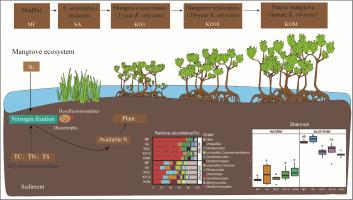Applied Soil Ecology ( IF 4.8 ) Pub Date : 2022-05-07 , DOI: 10.1016/j.apsoil.2022.104519 Xiaofang Huang 1, 2, 3, 4, 5 , Jianxiang Feng 6 , Junde Dong 1, 2, 3, 4 , Jian Zhang 1, 2, 3, 4, 5 , Qingsong Yang 1, 2, 3, 4 , Chenxi Yu 1, 2, 3, 4 , Meilin Wu 1, 2 , Wenqian Zhang 1, 2, 3, 4, 5 , Juan Ling 1, 2, 3, 4

|
Ecological restoration using native mangrove species (i.e., Kandelia obovata) is a practical approach for controlling Spartina alterniflora invasion in the coastal wetlands. Diazotrophs play a critical role in enhancing productivity of both S. alterniflora and mangrove plant, via providing new nitrogen to the coastal wetlands ecosystems. However, response of the diazotrophic community to S. alterniflora invasion and subsequent mangrove restoration remains unclear. The present study monitored sediment physicochemical properties and diazotrophic communities across a chronosequence of restored mangrove wetland (bare mudflat, invasive S. alterniflora stands, 3-year and 10-year K. obovata restoration areas, and mature K. obovata forests over 30 years). The results showed an orderly succession in the sediment properties and diazotrophic community composition after S. alterniflora invasion and along mangrove restoration chronosequences. Almost all sediment nutrient contents (e.g., TC, TN, and C/N) were significantly (P < 0.05) increased by S. alterniflora invasion, then they decreased sharply in the newly restored mangrove and increased gradually with restoration ages, with the highest values in the mature mangrove. The diazotrophs demonstrated distinct community structure in different seasons. Diazotrophic alpha diversity increased with S. alterniflora invasion and mangrove restoration age in winter. Sulfate-reducing bacteria (SRB) was the dominant diazotrophic group, especially Desulfuromonadales. Moreover, network analyses revealed that SRB groups were the major keystone taxa. The relative abundance of Desulfuromonadales decreased, while the abundance of Chromatiales increased gradually with the S. alterniflora invasion and mangrove restoration age. Redundancy analysis revealed that TC, TN, and TS were the significant (P < 0.05) environmental factors in altering sediment diazotrophic communities in both seasons. These findings expand the current understanding of succession patterns of diazotrophic communities in mangrove restoration and provide new perspectives on the sustainable management of mangrove ecosystems.
中文翻译:

互花米草入侵和红树林恢复改变了沉积物固氮群落的多样性和组成
使用本地红树林物种(即,Kandelia obovata )进行生态恢复是控制沿海湿地互花米草入侵的一种实用方法。固氮菌通过为沿海湿地生态系统提供新的氮,在提高互花米草和红树林植物的生产力方面发挥着关键作用。然而,固氮群落对互花米草入侵和随后的红树林恢复的反应仍不清楚。本研究监测了恢复的红树林湿地(裸泥滩、侵入性互花米草林、3 年和 10 年K. obovata )时间序列中的沉积物理化性质和固氮群落恢复区和成熟的K. obovata森林超过 30 年)。结果表明,互花米草入侵后和沿红树林恢复时间序列,沉积物性质和固氮群落组成有序演替。几乎所有沉积物养分含量(如 TC、TN 和 C/N)均因互花米草入侵而显着增加( P < 0.05),然后在新恢复的红树林中急剧下降,并随着恢复年龄逐渐增加,最高成熟红树林的价值。固氮菌在不同季节表现出明显的群落结构。固氮营养 α 多样性随着互花米草的增加而增加冬季入侵和红树林恢复年龄。硫酸盐还原菌(SRB)是主要的固氮菌群,尤其是脱硫单胞菌目。此外,网络分析显示 SRB 组是主要的关键类群。随着互花米草入侵和红树林恢复年龄的增长,脱硫单胞菌目相对丰度下降,而色度单胞菌目丰度逐渐增加。冗余分析显示 TC、TN 和 TS 是显着的(P < 0.05)在两个季节改变沉积物固氮群落的环境因素。这些发现扩展了目前对红树林恢复中固氮群落演替模式的理解,并为红树林生态系统的可持续管理提供了新的视角。



























 京公网安备 11010802027423号
京公网安备 11010802027423号